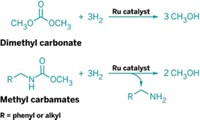Advertisement
Grab your lab coat. Let's get started
Welcome!
Welcome!
Create an account below to get 6 C&EN articles per month, receive newsletters and more - all free.
It seems this is your first time logging in online. Please enter the following information to continue.
As an ACS member you automatically get access to this site. All we need is few more details to create your reading experience.
Not you? Sign in with a different account.
Not you? Sign in with a different account.
ERROR 1
ERROR 1
ERROR 2
ERROR 2
ERROR 2
ERROR 2
ERROR 2
Password and Confirm password must match.
If you have an ACS member number, please enter it here so we can link this account to your membership. (optional)
ERROR 2
ACS values your privacy. By submitting your information, you are gaining access to C&EN and subscribing to our weekly newsletter. We use the information you provide to make your reading experience better, and we will never sell your data to third party members.
Environment
Carbon DioxideFixation With Copper
May 3, 2010
| A version of this story appeared in
Volume 88, Issue 18
BOTH THE ARTICLE "New Way To 'Fix' CO2" (C&EN, Jan. 18, page 6) and the original report of work led by Elisabeth Bouwman of Leiden University (Science 2010, 327, 313) failed to note that the reduction of CO2 by a Cu(I) complex has been observed at least twice before in the past decade. The first time was by Louis J. Farrugia, Stefan Lopinski, Paul A. Lovatt, and Robert D. Peacock (Inorg. Chem. 2001, 40, 558) and then by us (Acta Cryst. 2005, E61, m1904).
Moderation of global warming/climate change by this approach to CO2 sequestration did not appear practical to us because the marketing and/or disposal of the resulting megatons of oxalic acid and/or oxalates would present significant new disposal problems. However, it will be interesting to see if, as the Science article suggests, a useful large-volume product such as methanol can be obtained as an end product.
Robert T. Stibrany
Joseph Potenza
Piscataway, N.J.
Harvey Schugar
Huntington, Vt.
Response From Elisabeth Bouwman
We saw the two earlier papers when we first found our oxalate structure. After the exciting finding of our system's electrocatalytic activity, regrettably I forgot to check that the two papers were included in the list of references, for which I apologize. It is the catalytic reactivity that may have a major impact on development of a sustainable society. This type of fundamental chemical advance could lead to methods for sequestering rising CO2 levels while at the same time making useful chemicals, although the economic viability of such a process has yet to be determined.



Join the conversation
Contact the reporter
Submit a Letter to the Editor for publication
Engage with us on Twitter